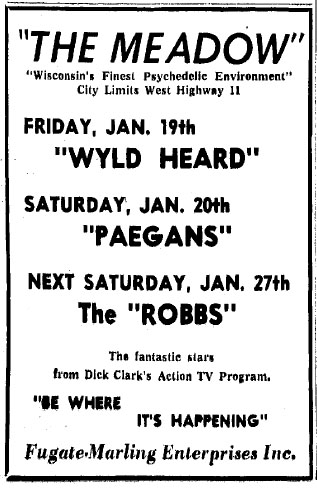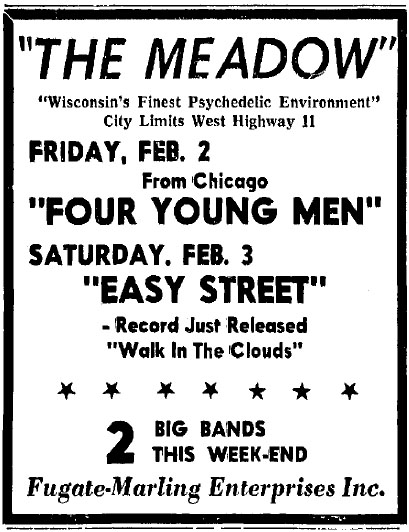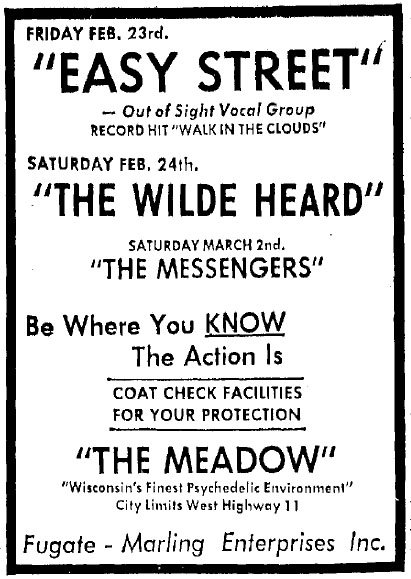

Page 2
At the start of 1968, the Meadow became a popular destination for young people in senior high school and beyond, attracting 600 to 700 people on Friday and Saturday nights. Some shows attracted closer to a thousand. Open 8:00 p.m. to midnight, the atmosphere was one of psychedelic sights and sounds. Purple black-lights glowed around the walls, some created by hanging white plastic sheets on which were painted Day-Glo images. A ceiling-mounted slide projector displayed ever changing patterns on the main dance floor. A flickering strobe light created the illusion of people dancing in stop-action. Bands typically performed on a low-rise stage in front of a long plastic sheet. Behind the sheet, light show designer Doug Hull of Flower Power & Light Company and his assistants operated rotating lights, prisms, a movie projector, slide projectors, and an overhead projector all of which projected images on the back of the sheet behind the band. The audience, many of whom were seated on a large carpet in front of the stage, enjoyed the music and the light shows. Flower Power & Light presented "liquid emotion" light shows using colored oils in a clear glass dish placed on the overhead projector's fresnel lens that projected pulsating protoplasm images. "Go-go girls" sometimes shadow-danced behind the sheet along with the light show images, all to the beat of the music.

 |
Local talent bookings at the Meadow continued in
January with
appearances of popular bands from the Stateline area. Peoria's Wylde Heard and Rockford's Paegans performed on January 19 and 20, while Madison's popular Epics were booked a week later on January 26. The Robbs, originally from Oconomowoc, got top billing at the Meadow on January 27. They were the house band for Dick Clark's television program, "Where the Action Is" and had scored with Midwest hits Race with the Wind and Bittersweet. While doing well regionally, none of their records ever cracked the Billboard Hot 100 on a national level. Nonetheless, the Robbs were a popular draw for the Meadow audience. I remember coming up from Beloit for the show with my friend Dennis. |
| The Wylde Heard, originally from Peoria, made their home in Janesville. Their first recording, Stop It Girl b/w Take It On Home was picked up by the Phillips label. A photo of the band being welcomed to the label by executive VP Irwin Steinberg can be found on page 8 of Billboard magazine, April 29, 1967. The photo used for the poster on the right was taken at "Heard Manor," an old house on the edge of Janesville that served as home for the band. Band members included Jim Croegaert (keyboards), Paul “Bird” Burson (guitar), Bill Sutton (bass), and Ron “Drummer” Bednar (drums). Like many bands at that time, the Heard covered popular songs, but also played original material including the two previously mentioned songs written by Croegaert. Late that summer, the Heard broke up and members Jim and Bill joined Russ Dashiell (guitar) and Rick Jaeger (drums) of the Beau Gentry to form a short-lived band called Masque. Masque also performed at the Meadow before that band dissolved by the end of 1968. (Poster courtesy of Jim and Janalee Croegaert) |
 |
  |
A four-piece band from Southeastern Wisconsin performed on February 3. Formerly the Matadors, they became Easy Street in 1967 and toured Alaska with the Rascals. Their record, Walking In the Clouds, was popular in parts of Wisconsin. Paraphernalia, a Madison all-girl band, performed around the area including a gig at the Meadow on February 9. Another critically acclaimed Madison band, Spectre Inc, performed there on February 10, the same night Harvey Scales & the Seven Sounds were booked at the Factory, Ken Adamany's music venue on Gorham Street in Madison.
|
| The Beau Gentry and Robin & the Three Hoods reappeared
at the Meadow in mid-February. Easy Street and the
Wylde Heard also made return appearances the last weekend of that
month. The Meadow opened up its "Swamp Shop" in February selling posters, black lights, tapestries, and other psychedelic decor. A coat check service was also initiated. Coming up to kick off the month of March was an appearance by Milwaukee recording stars, the Messengers.
|
  |
 Meanwhile, Jimi Hendrix lit up the Madison music scene at Ken Adamany's Factory on Tuesday, February 27, about six months after his famous Monterey Pop Festival gig. Hendrix brought along Mark Boyle's Sense Laboratory light show from England and an opening act, the Soft Machine. The show attracted a large audience from the area. According to Capital Times "Fun & Night Life" columnist Gary Rettgen, Adamany took no chances with Hendrix after the tragic loss of Otis Redding and his band, who drowned just months before when their plane crashed into a chilly Lake Monona on their way to the Factory. Hendrix and company traveled to Madison by truck, but the vehicle reportedly broke down and the Experience was two hours late for their first show. Audiences for both the early and late shows apparently didn't mind the wait. Wilson Picket was the next national act booked at the Factory for Monday, March 11. |
© Joe J. Accardi, 2010